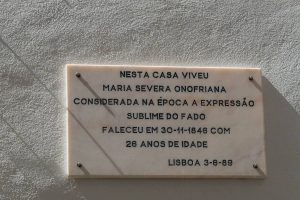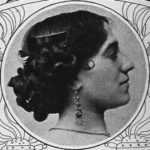Maria Severa is, perhaps, the first fado icon in Portugal.
She only lived for 26 years – from 1820 to 1846 –, but Maria Severa Onofriana, her full name, revolutionized the Lisbon of her time, but if Lisbon’s fame was great during her lifetime, it was even greater after her death.
The writer Júlio Dantas was one of those responsible for this aura of fame for his novel and, later, for the play “A Severa”, which Leitão de Barros later adapted to the cinema, which was the first Portuguese sound film. Starring Dina Tereza, the film premiered in June 1931 at Teatro S. Luiz, where it ran for six months and was seen by 200,000 spectators.

The character in the novel, from which the myth of Severa was constructed, does not fully correspond to the real life of the fado singer who was, among others, the lover of the last Count of Vimioso. Actress Palmira Bastos, who played the character of Severa on stage, stated that she was “the Portuguese lady with the camellias”.
Maria Severa was distinguished by the “quarrelsome” character that she inherited from her mother, a famous and feared prostitute from Mouraria, Maria Barbuda, but essentially by her voice and the way she sang, in addition to her slender figure. She was “tall, slender but not thin, opulent breasts, very white skin, black eyes, thick black hair, bushy eyebrows, small, very red mouth, beautiful teeth, thin waist and small feet”, this is how a contemporary described her.
The painter Francisco Metrass (1825-1861) even sketched her portrait, without ever finishing it.
Severa lived in the midst of the advent of liberalism when the end of the absolutist and land-tenant Old Regime began to be felt. The Portuguese, accustomed to the absolute power of the King, now knew a fundamental text, the Constitution that distributed powers, guaranteed freedoms and rights. A period of reforms and popular revolts, where women’s social role expanded.
Minister Mouzinho da Silveira then proclaimed that it was necessary “to bring the Nation into the Guild of Europe”. They wanted a civilized, modern, European Portugal. Severa’s life also reflects these contradictions.
Born in the Anjos tents, in Lisbon, in the year 1820, as her baptism certificate attests, daughter of Severo Manuel and Ana Gertrudes, she moved to Madragoa, a neighborhood of sailors and miscreants at the time, where her mother had a tavern on Rua Vicente Borga. From Madragoa, always accompanied by her mother, she moved to Bairro Alto and from here to Mouraria where she died, with a brief stay at the palace of Conde Vimioso, to Campo Grande.
This is stated by her contemporaries, who left written memories about the slender Severa, who in addition to singing fado, accompanied herself on a peg guitar, and even wrote the poems she sang.

A companion of hers, Manuel Botas, describes her peculiar way of singing: “Sometimes she remained melancholic, at those moments she sang with such feeling that it made a deep impression on us. He heard it on one occasion, at Café do Bola, in Guia. She was a doleful fado, singing about the hard lives of those who have no home or joy, she felt well what she was singing because her eyes were filled with tears.”
The writer Augusto Palmeirim, when visiting her at her home in Bairro Alto, emphasizes that on a “games table there was a guitar, the inseparable companion of her triumphs”.
The writer Raimundo Bulhão Pato (1828-1912), who knew her, confided one night to a friend: “The poor girl was a very interesting fado singer, like Mouraria will never have again”.
Severa, of whom there is no record of his voice, is said to have been the first person to sing fados in the street and raise their problems by representing the people, and the reason why fado spread to the level of a national entity which it is today. She died poor and abandoned, in a miserable brothel on Rua do Capelão, on November 30, 1846.
It is said that her last words were: “I die without ever having lived” – she was 26 years old.
She was buried in a common grave, without a coffin, as was her wish expressed in her own verses that she sang:

I have a bitter life
Oh what an unhappy fate!
But if I’m so unfortunate
It wasn’t me who wanted it that way.When I die, girls,
Have no regrets
And to the sound of your songs
Throw me in the mass grave.
It was after her death that she became, in fact, a symbol of Fado.
In fact, since then the authors of fado lyrics have never stopped celebrating her, prompted by the legend of this woman.
Source: mundoportugues.pt












Só musica e emoção com cultura!! 🎧🎧